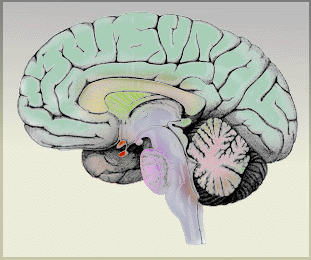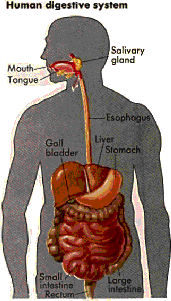

By: Hened Baetens and Ian Butcher
BODY
WORKS


By:
Hened Baetens
and
Ian Butcher
___________________________________________________________________________________________
There are several important systems which make up every human body.
Here are a few for you to examine:
The skeletal system consists of over 200 hundred bones, some of which are
connected in a fixed manner and many which are part of a moving joint. The
skeletal system is what gives each person their height and size and without
it people would look like jellyfish, big blobs of muscle and organs that
were very soft and squishy. The fixed bones are part of a shield to protect
soft inner organs such as the skull protects the brain and the ribs protect
the lungs and heart. Bones such as the forearm and upper arm are joined together
at a moving joint, and allow your arm to bend. Some bones break but they
are able to grow back together and are as strong as before the break.
 Digestive
System
Digestive
System
The purpose of the digestive system is to break down foods into their smallest
usable components and then to absorb these components into the blood stream.
It consists of the mouth where food is entered into the body, the oesophagus
which takes the food to the stomach, and the stomach which produces acids
to break down food. The stomach then empties into the small intestines which
adds enzymes that help break down the food even more, and then the intestine
begins to digest substances into the body. The small intestine continues
to move the blood through it until the food enters the large intestine. By
now most of what is left is water, waste and minerals and the large intestine
absorbs the water and minerals. The waste is disposed of through the rectum.
The respiratory system is how the body brings clean oxygen to the blood and removes carbon dioxide from the body. We breath air in through our nose or mouth, down the windpipe and into our lungs, which expand to hold the air. The lungs break down the air to get oxygen, and then absorb this oxygen through the walls of the lungs directly into the blood. As oxygen is being absorbed by the body, carbon dioxide is leaving the blood and entering the lungs, by passing through the blood vessel and lung walls. When we exhale the lungs contract and force the carbon dioxide and air from our bodies. This process happens several times a minute and increase during activity as the body needs to burn more energy and requires more oxygen to do this. (When we sleep the process happens less often).
There are over 97000 kilometers of blood vessels in the human body (enough
to go from Canada's east coast to west coast and back 12
times!). The largest part of this system, called the
circulatory system because it circulates - moves - blood around the body,
is the
heart.
It is in the middle of the chest behind the ribs. Blood leaves the heart
through arteries which take oxygen red blood cells (small organisms) filled
with blood to all parts of the body, as well as nutrients, minerals and white
blood cells which attack disease, bacteria and even poisons. Blood also helps
protect the body from infection when the skin is punctured by clotting and
sealing the body back while the skin regenerates. Veins take blood from the
body back to the heart carrying carbon dioxide, ammonia and other wastes.
The right side of the heart pumps the dirty blood to lungs where it expels
the wastes and carbon dioxide and absorbs oxygen and then returns the clean
blood to the left side of the heart which pumps it out to the body. As you
exercise and your body is requiring more oxygen, the heart must pump faster
to get all the oxygen to the muscles as they need it. It is important to
note that
physical
fitness and
eating
healthy are also vital components to keeping your body functioning
at its peak!
The nervous system regulates and coordinates the activities of all the other systems of the body. It enables the body to akjust to changes that occur within itself and in its surroundings. The nervous system is made up of countless nerve cells called neurons. These neurons are the way our brain sends messages to our body. The brain and spinal cord are part of what is call the Central Nervous System which functions as the control centre of the entire nervous system. The central nervous system makes some simple decisions such as directing a hand to move away from a hot object, which is referred to as a simple relex, but most of the decisions involve the brain on a much greater scale. The brain is still very difficult for us to understand completely. Our brains are capable of so much more than we will ever know!
The final system, the reproductive system, is the means by which humans are
able to have children. The female and the male systems are very different,
but work together to create a new life -- and this is how you were born!
The female body has ovaries, which are where eggs are produced. These eggs,
unlike chicken eggs you may have seen at home, are so small that without
a microscope you would not be able to see one. The ovaries release one egg
every 28 days. The egg travels down a tube called the fallopian tube until
it reaches the uterus. If the egg is fertalized it attaches itself to the
wall and begins to grow into a fetus (and eventually, around nine months
later, a baby is born!). The male parts of this process comes in the sperm
which fertilizes the female egg. The sperm is generated in the male testicles
and if the sperm is ejaculated into the female vagina at the time when an
egg is present -- a new life is then created!
Your body is where you live. Please take care of it!